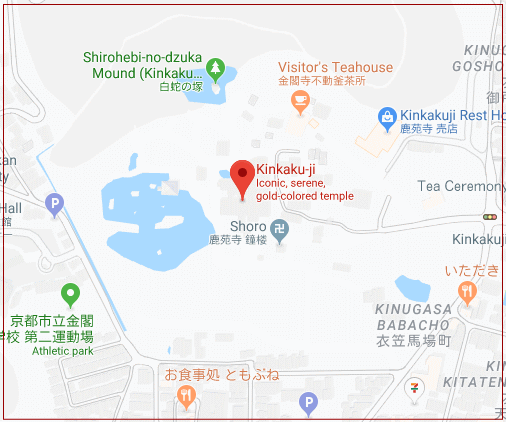A Gorgeous Walk Around a Mirror-Surface Pond
 He might have been strolling through this garden many times, sometimes so proud and content with what he had achieved. And sometimes reminiscent of how he had to run from rebellious attacks in his childhood. Or how he oppressed powerful Shugo Daimyōs (provincial governor lords) and started to dominate the entire nation, as the third shogun of the Muromachi Bakufu (shogunate).
He might have been strolling through this garden many times, sometimes so proud and content with what he had achieved. And sometimes reminiscent of how he had to run from rebellious attacks in his childhood. Or how he oppressed powerful Shugo Daimyōs (provincial governor lords) and started to dominate the entire nation, as the third shogun of the Muromachi Bakufu (shogunate).
Now it’s your turn to promenade this magnificent garden. With a pond in the centre, it’s a typical Kaiyū Shiki Teien (Walk-around or pond-centred garden) in the Muromachi Period (1392 - 1573). Reflecting the dazzling golden architecture on the mirror-like surface, the pond Kyōko Chi (Mirror Pond) provides a sea to tiny islands in various sizes: Ashiwara Jima (Reed-field Island), Tsuru Jima (Crane Island), and Kame Jima (Tortoise Island). Also, decorative rocks in the pond were offered by various lords in the time and individually named after the donators. With Mt. Kinugasa in the background, the scenery here is esteemed as one of the most beautiful scenes in Japan.
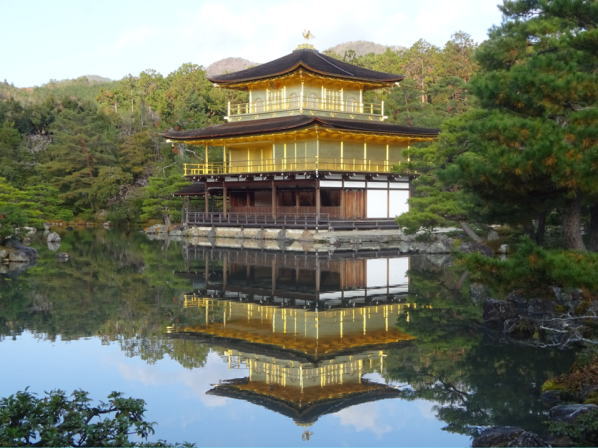 Yoshimitsu probably loved to see Rikushū No Matsu (Boat-shaped pine tree) he himself planted, and now located at the north of Hōjō House (Priest’s Room) donated by Emperor Gomizunoo in 1678. This pine tree is considered one of the “Three Important Pine Trees in Kyoto” today. When he was served tea, water must have been taken from Ginga Sen (Silver river fountain), and he even might have washed his hands using Ganka Sui (Under-rock water).
Yoshimitsu probably loved to see Rikushū No Matsu (Boat-shaped pine tree) he himself planted, and now located at the north of Hōjō House (Priest’s Room) donated by Emperor Gomizunoo in 1678. This pine tree is considered one of the “Three Important Pine Trees in Kyoto” today. When he was served tea, water must have been taken from Ginga Sen (Silver river fountain), and he even might have washed his hands using Ganka Sui (Under-rock water).
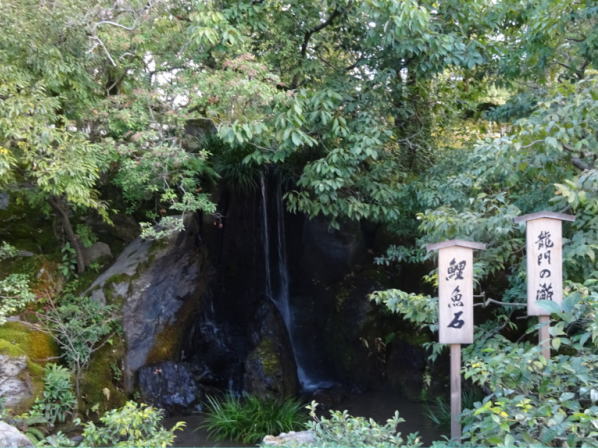 And don’t forget to check Ryūmon No Taki (lit. Dragon Gate Waterfall), and the stone called Rigyoseki (Carp Stone) placed there! Because it tells you the ancient Chinese story of the “Dragon Gate”. But it’s not about a kung fu star. It describes a carp swimming its way up against a waterfall to transform into a dragon.
And don’t forget to check Ryūmon No Taki (lit. Dragon Gate Waterfall), and the stone called Rigyoseki (Carp Stone) placed there! Because it tells you the ancient Chinese story of the “Dragon Gate”. But it’s not about a kung fu star. It describes a carp swimming its way up against a waterfall to transform into a dragon.
Far behind Kinkaku or the Golden Pavillion is An Min Taku (lit. Peaceful Sleep Pond), a remaining structure from the previous owner of the land and still supplying water to the Kyōko Chi pond. On the island in the lagoon is located a small pagoda named Hakuja No Tsuka (White Snake Mound) to honour a white serpent spirit considered to be a servant of the Bezaiten Goddess (water-related deity).
The Beginning of the Kitayama Culture
 The land where the temple is located once belonged toa family called Saionji, descendants of Saionji Saionji Kintsune, a political figure in the Kamakura Period (1192 - 1333). Yoshimitsu took a liking of this location and obtained it in 1396. He had just retired as a shogun and become a monk in 1395 at the age of 38. Converting this now deserted site into a gorgeously elaborated architectural and garden masterpiece, he might have boasted it as an expression of a Buddha land. Soon it began to be dubbed Kitayama Palace.
The land where the temple is located once belonged toa family called Saionji, descendants of Saionji Saionji Kintsune, a political figure in the Kamakura Period (1192 - 1333). Yoshimitsu took a liking of this location and obtained it in 1396. He had just retired as a shogun and become a monk in 1395 at the age of 38. Converting this now deserted site into a gorgeously elaborated architectural and garden masterpiece, he might have boasted it as an expression of a Buddha land. Soon it began to be dubbed Kitayama Palace.
Kitayama Palace played a key role, staging both political and cultural centres in the age. It was a guest house for Emperor Gokomatsu, a frequent visitor to the palace, as well as for delegations from China (Ming), a then trade partner. The profits obtained from the trades with the dynasty had financed the enhancement of the site, which leads to the blooming of the contemporary culture called Kitayama style.
Kinkaku as a Stupa for Buddha Relics
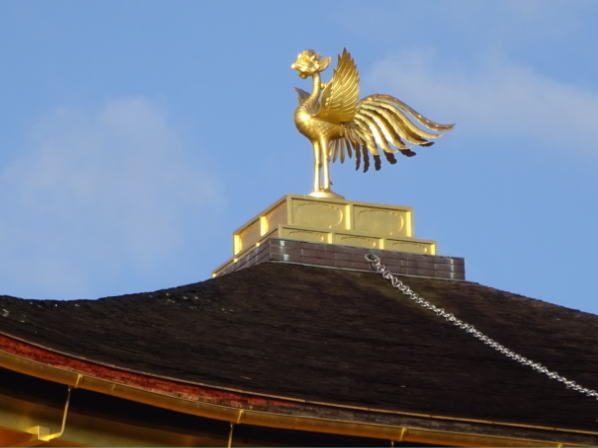 In fact, Yoshimitsu never left his political games even after retirement and ordination. It might have been a cover for his real intention of covertly keeping his influence. So why did he build Kinkaku or the Golden Pavillion? To show his never-fading power? Or because of his innocent plan to get wholly dedicated to Buddhist life? There is no definite answer.
In fact, Yoshimitsu never left his political games even after retirement and ordination. It might have been a cover for his real intention of covertly keeping his influence. So why did he build Kinkaku or the Golden Pavillion? To show his never-fading power? Or because of his innocent plan to get wholly dedicated to Buddhist life? There is no definite answer.
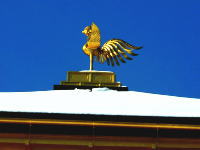 Putting all this aside, Kinkaku is one of the most valuable buildings created in the Muromachi Period. In there three different styles are perfectly blended. The first floor uses the Shinden Zukuri (Aristocratic) style, the second, the Buke Zukuri (Warrior style) and the third, the Chinese Zen Buddhist style. The rooms are called Hosui In (Dharma Water Room), Chō On Dō (Tide Sound Cave), and Kukkyo Chō (Supreme Pursuit Summit) respectively. The second and third tiers of the pavilion are coated with lacquer and gilded with gold-leaf. The roofs are thatched with shingles of Sawara (a tree similar to cypress). On top of the roof, a statue of Chinese phoenix, auspicious symbol, is decorated.
Putting all this aside, Kinkaku is one of the most valuable buildings created in the Muromachi Period. In there three different styles are perfectly blended. The first floor uses the Shinden Zukuri (Aristocratic) style, the second, the Buke Zukuri (Warrior style) and the third, the Chinese Zen Buddhist style. The rooms are called Hosui In (Dharma Water Room), Chō On Dō (Tide Sound Cave), and Kukkyo Chō (Supreme Pursuit Summit) respectively. The second and third tiers of the pavilion are coated with lacquer and gilded with gold-leaf. The roofs are thatched with shingles of Sawara (a tree similar to cypress). On top of the roof, a statue of Chinese phoenix, auspicious symbol, is decorated.
Rokuon Ji Temple
After Yoshimitsu’s death, Master Musōkokushi (the first chief abbot of the temple) founded the temple following Yoshimitsu’s will. The name Rokuonji was coined from the posthumous title of the shogun. Despite that official name, it’s more popularly called Kinkaku Ji for its famous golden stupa. Listed as a World Cultural Heritage site in 1994, the temple belongs to the Shōkoku Ji school of the Rinzai Buddhist denomination.
Sekkatei Tea House
 There was a tea master Sōwa Kanamori in the Edo Period (1603 - 1867). Created and loved by him, this tea house is called Sekkatei (lit. Beautiful Sunset Cabin). As its name suggests, it’s famous for the beautiful sunset view seen from inside. The front pillar of the house is made of a single Nandin tree and is an outstanding rarity.
There was a tea master Sōwa Kanamori in the Edo Period (1603 - 1867). Created and loved by him, this tea house is called Sekkatei (lit. Beautiful Sunset Cabin). As its name suggests, it’s famous for the beautiful sunset view seen from inside. The front pillar of the house is made of a single Nandin tree and is an outstanding rarity.
Achala Shrine
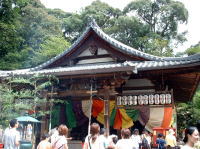 A stone Achala (Fudomyō-o) image is enshrined here. The image is a legendary workpiece carved by Master Kōbo (or Kūkai), the founder of the Shingon Buddhist denomination. The Achala image is worshipped by many people. The shrine-opening service is given twice a year; on February 3 and August 16.
A stone Achala (Fudomyō-o) image is enshrined here. The image is a legendary workpiece carved by Master Kōbo (or Kūkai), the founder of the Shingon Buddhist denomination. The Achala image is worshipped by many people. The shrine-opening service is given twice a year; on February 3 and August 16.
|







